Subphylum Vertebrata Suborder Serpentes Scientific name Dispholidus typus Rank Species | Phylum Chordata Higher classification Dispholidus | |
 | ||
Similar Snake, Bitis arietans, Reptile, Mamba, Cape cobra | ||
Boomslang snake kills a chameleon quickly swiftly
The boomslang /ˈboʊmslɑːŋ/, also /ˈbɔːm/, /sləŋ/ or /ˈbuːmslæŋ/ (spelling pronunciation) (Dispholidus typus) is a large, venomous snake in the family Colubridae.
Contents
- Boomslang snake kills a chameleon quickly swiftly
- Why boomslang snake venom makes you bleed from your eyes
- Taxonomy and etymology
- Description
- Geographic range
- Reproduction
- Behavior and diet
- Venom
- In Popular Culture
- References
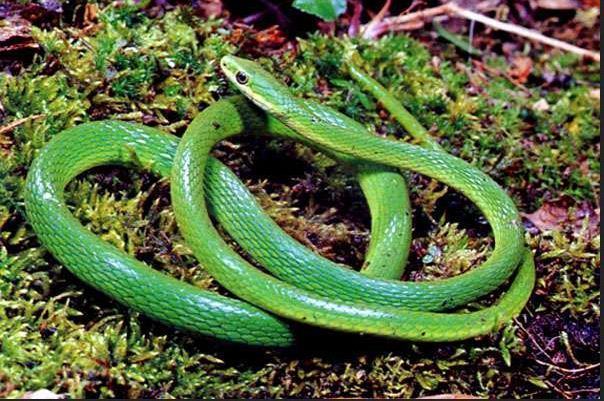
Why boomslang snake venom makes you bleed from your eyes
Taxonomy and etymology
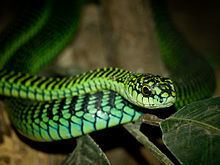
It is currently the only species in its genus, although several species and subspecies have been described in the past. Its name means "tree snake" in Afrikaans and Dutch – boom meaning "tree" (a cognate of "beam"), and slang meaning "snake". In Afrikaans, the name is pronounced [ˈboəmslɐŋ]. The snake is thought to be closely related to members of the genera Thelotornis, Thrasops, Rhamnophis, and Xyelodontophis, with which it forms the taxonomic tribe Dispholidini.
Description
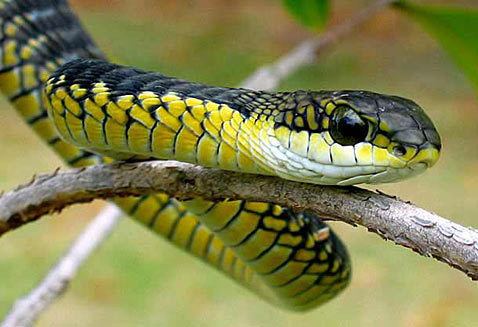
The average adult boomslang is 100–160 cm (3¼–5¼ feet) in total length, but some exceed 183 cm (6 feet). The eyes are exceptionally large, and the head has a characteristic egg-like shape. Coloration is very variable. Males are light green with black or blue scale edges, but adult females may be brown.
Weight varies from 175 to 510 g, with an average weight of 299.4 g.
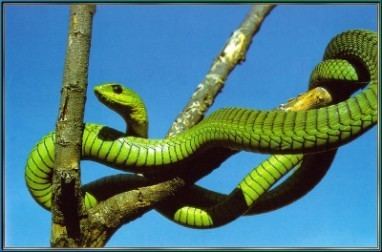
In this species, the head is distinct from the neck and the canthus rostralis is distinct. The pupils of the very large eyes are round. Boomslangs have excellent eyesight and often move their heads from side to side to get a better view of objects directly in front of them. The maxillary teeth are small anteriorly, seven or eight in number, followed by three very large, grooved fangs situated below each eye. The mandibular teeth are subequal. The body is slightly compressed. The dorsal scales are very narrow, oblique, strongly keeled, with apical pits, arranged in 19 or 21 rows. The tail is long, and the subcaudals are paired. Ventrals are 164–201; the anal plate is divided; and the subcaudals are 91–131.
Geographic range
The boomslang is native and restricted to Sub-Saharan Africa.
Reproduction
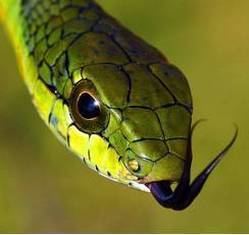
Boomslangs are oviparous, and produce up to 30 eggs which are deposited in hollow tree trunks or rotting logs. The eggs have a relatively long (three months on average) incubation period. Male hatchlings are grey with blue speckles, and female hatchlings are a pale brown. They attain their adult coloration after several years. Hatchlings are approximately 20 cm in length and pose no threat to humans, but are dangerously venomous by the time they reach a length of about 45 cm and a girth as thick as an adult's smallest finger.
Behavior and diet
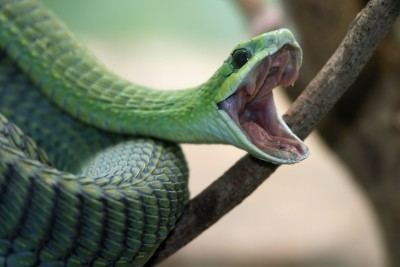
Boomslangs are diurnal and almost exclusively arboreal. They are reclusive, and flee from anything too large to eat. Their diet includes chameleons and other arboreal lizards, frogs, and occasionally small mammals, birds, and eggs from nesting birds, all of which they swallow whole. During cool weather, they hibernate for moderate periods, often curling up inside the enclosed nests of birds such as weavers.
Venom
Many venomous members of the family Colubridae are harmless to humans because of small venom glands and inefficient fangs. However, the boomslang is a notable exception in that it has a highly potent venom, which it delivers through large fangs located in the back of the jaw. Boomslangs are able to open their jaws up to 170° when biting. The venom of the boomslang is primarily a hemotoxin; it disables the coagulation process and the victim may die as a result of internal and external bleeding. The venom has been observed to cause hemorrhage into tissues such as muscle and brain. Other signs and symptoms include headache, nausea, sleepiness, and mental disorders.
Because boomslang venom is slow-acting, symptoms may not become apparent until many hours after the bite. Although the absence of symptoms provides sufficient time for procuring antivenom, it can also provide victims with false reassurance, leading to them underestimating the seriousness of the bite. Snakes of any species may sometimes fail to inject venom when they bite (a so-called "dry bite"), so after a few hours without any noticeable effects, victims of boomslang bites may wrongly believe that their injury is not serious or life-threatening.
An adult boomslang has 1.6 to 8 mg of venom. Its median lethal dose (LD50) in mice is 0.1 mg/kg (intravenously). 0.071 mg/kg(IV) has also been reported.
In 1957, the well-known herpetologist Karl Schmidt died after being bitten by a juvenile boomslang which he doubted could produce a fatal dose. Unfortunately, he was wrong; nevertheless, he made notes on the symptoms he experienced almost to the end. D. S. Chapman reported eight serious envenomations by boomslangs between 1919 and 1962, two of which were fatal.
The South African Vaccine Producers manufactures a monovalent antivenom for use in boomslang envenomations. The monovalent antivenom was first developed during the 40s. Treatment of bites may also require complete blood transfusions, especially after 24 to 48 hours without antivenom.
The boomslang is a timid snake, and bites generally occur only when people attempt to handle, catch, or kill the animal. When confronted and cornered, they inflate their necks and assume their striking "S"-shaped pose. The above data suggest boomslangs are unlikely to be a significant source of human fatalities throughout their distribution range.
In Popular Culture
In the Harry Potter series by author J.K. Rowling, Boomslang skin is one of the few known ingredients of the Polyjuice Potion.
